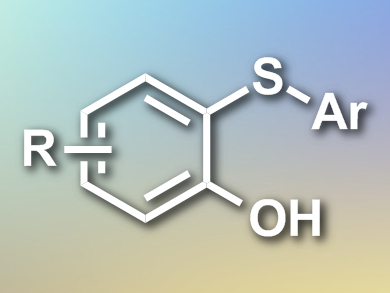Over the past two decades, countless catalytic reactions have been developed to functionalize organic substrates by C–H activation. To determine the selectivity of C–H activation, directing groups play a crucial role. However, successful examples of C–H activation directed by sulfur-containing groups are rare, owing to strong coordination by sulfur, which quenches metal catalysts, and the likelihood of sulfur’s oxidation to form sulfoxides or sulfones, which limits applicable oxidants.
Dawei Wang, Jiangnan University, Wuxi, China, Xiaodong Shi, University of South Florida, Tampa, USA, and colleagues have discovered a cascade hydroxylation/S-arylation of thiophenols, catalyzed by ligand-free CuI with molecular O2 as the oxidant. O2 easily oxidizes thiophenol to form the disulfide. During an attempted C–H arylation of the disulfide with arylboronic acid and CuI, the C–H hydroxylation product was formed.
Various 2-(phenylthio)phenol derivatives, which are normally subject to overoxidation in such reactions, were successfully prepared. This indicates the potential of disulfide-directed C–H activation as a strategy to functional sulfur-containing compounds. The team’s mechanistic investigations revealed the disulfide as the key component in directing C–H oxidation.
- Copper-Catalyzed Reaction Cascade of Thiophenol Hydroxylation and S-Arylation through Disulfide-Directed C−H Activation,
Dawei Wang, Xin Yu, Wei Yao, Wenkang Hu, Chenyang Ge, Xiaodong Shi,
Chem. Eur. J. 2016.
DOI: 10.1002/chem.201600597



